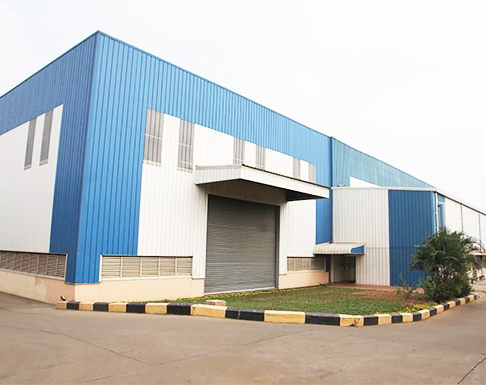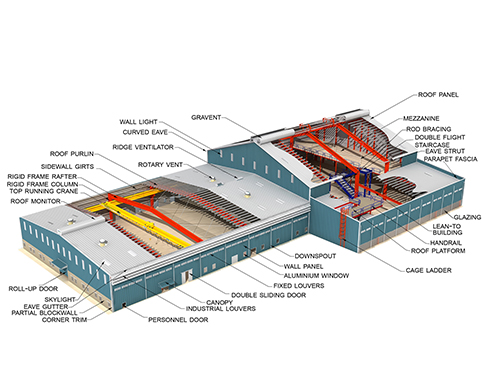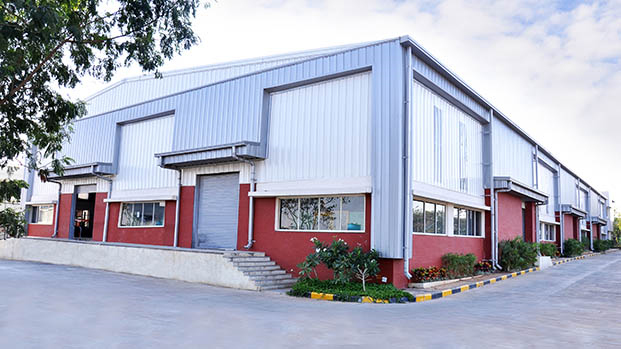PEB DIVISION
JCL Infra Private Limited is a one-stop-solution for all building requirements of varied customers. Our pre engineered steel buildings are uniquely designed and fabricated to suit your requirements. Built strictly following the international standards, these buildings consist of different components, meticulously designed to be compatible to each other. The fabrication of these components is carried out in factory under strict quality control as per detailed shop drawing. These components are transported to end user’s site with proper markings and assembled at the project site as per erection drawings. We cater to industrial, commercial and institutional requirements and provide enhanced speed in delivery and erection. We also provide flexibility in expansion and withstand severest weather conditions to deliver the best of pre-engineered solutions. These buildings are available in large multidimensional spans; lean to roof at all required heights and side claddings. They feature a structural steel framework of primary and secondary members (rigid frame, beams, purlins and grits, trusses and columns) on to which cladding and roofing components are attached. The plant is equipped with high precision CNC machines to fabricate and supply quality-replete steel buildings.

Steel is the basic material that is used in the construction of a pre engineered building. The usage of steel negates the usage of concrete and cement to a great extent thus mitigating any harmful effects associated with them.Moreover steel has a substantial amount of recycled content in it. The metal roof and wall panels used by PFPL have at least 25 % recycled content in them. They are also 100 % recyclable in the future after the building has lived its life. The other major advantages of steel is that it has lower life cycle cost as it is easier to maintain.The pre-engineered steel building system in itself offers great advantages to the customer as a more feasible, practical and efficient alternative to conventional buildings. The system has earned acceptance across the world and is gaining rapid ground in India as well. .
Some of the distinct advantages include:
- Durability - weather resistant, earthquake resistant.
- Value - Low initial investment, low maintenance costsli
- Environment friendly - All the materials can be recycled
- Flexible - Easy to expand, easy to setup and change
- Faster - Reduced construction time
- Aesthetics - Gives the engineer enough flexibility to create unique structures
Following are the components used by JCLIL for constructing steel buildings.
Main Frame
Rigid steel frames of the building are mainly considered as the Main Frames of PEB. PEB rigid frame comprises of tapered columns and tapered rafters (the fabricated tapered sections are referred to as built-up members). The tapered sections are fabricated using the state of art technology wherein the flanges are welded to the web. Splice plates are welded to the ends of the tapered sections. The frame is erected by bolting the splice plates of connecting sections together.
Purlins, Grits and Eave Struts
Purlins, Grits and Eave Struts are secondary structural members used to support the wall and roof panels. Purlins are used on the roof; Grits are used on the walls and Eave Struts are used at the intersection of the sidewall and the roof. Secondary members have two functions: they act as struts that help in resisting part of the longitudinal loads that are applied on the building such as wind and earthquake loads, and they provide lateral bracing to the compression flanges of the main frame members thereby increasing frame capacity.
Panels and Insulation
Panels used for sheeting purpose are generally of ribbed steel sheets used as roof and wall sheeting, roof and wall liners, partition and soft sheeting. The steel sheets are generally produced from steel coils having thickness 0.5 mm to 0.7 mm high tensile stress.
Why choose JCL Infra Private Limited?
- Stringent quality systems
- Faster cycle times
- Value-engineered solutions
- Continuous product improvement
- International presence and local service
- Trustworthy after sale service
- Comprehensive and detailed engineering output
- Attention to detail
- Thus, we provide a complete and the most trustworthy economical Structure solutions under one roof.
Components of Pre Engineered Buildings
- Pre Engineered Buildings are Steel Structures built over a structural concept of:
- Primary Framing System
- Secondary Framing System
- Roof Sheeting
- Wall Cladding
- Accessories
- Primary Framing System
- Primary framing consists of all structural elements which transfer load to the foundation and comprise of:
- Rigid Frames
- End Wall Frames
- Wind Bracing
- Crane Brackets
Why choose JCL Infra Private Limited?
| Evaluation Criteria | Peb Building | Concrete Building |
| Fabrication | Precise fabrication: Members fabricated in a controlled environment and up to 50% saving in fabrication time on site. | Fabrication done on site; Requires building the reinforcement cage and shuttering work prior to pouring. |
| Delivery and Logistics | Can be delivered in desired sequence anywhere in the world. | Might have to build batch plant on site if site is secluded or huge. |
| Installation Time | 50% saving in construction time. Fast Installation with no idle time. | Slow and time consuming: The contractor will have to wait for the previous cast to harden (14-28 days) before being able to cast next batch. |
| Quality | Quality of steel is guaranteed because
|
Many factors lead to quality deterioration
|
| Cost | Savings of 10%-15% for large span steel building. | Construction cost is high at site. |
| Industrial Applications | Saving on maintenance cost: Can easily handle equipment such as multiple cranes within building. Sways can be controlled. Precision can be achieved during installation. | Heavy equipment usage such as cranes is limited. |
| Commercial & Infrastructure Applications | Better aesthetics and longer spans can be achieved using steel as building component. | Limited designs are possible with concrete. |
COMPARISON BY APPLICATIONS FACTORIES
| Options | Cost of Construction | Speed of Construction | Ease of Construction |
| PEB | Most Economical | Fastest | Most Simple |
| Concrete | Less Economical | Slowest | Cumbersome |
WAREHOUSES
| Options | Cost of Construction | Speed of Construction | Ease of Construction |
| PEB | Most Economical | Fastest | Most Simple |
| Concrete | Less Economical | Slowest | Cumbersome |
MALLS & RETAIL SHOPPING CENTERS
| Options | Cost of Construction | Speed of Construction | Ease of Construction |
| PEB | Economical | Fastest | Most Simple |
| Concrete | Most Economical | Slowest | Most Cumbersome |
RECREATIONAL BUILDINGS
| Options | Cost of Construction | Speed of Construction | Ease of Construction |
| PEB | Economical | Fastest | Most Simple |
| Concrete | Most Economical | Slowest | Most Cumbersome |
STEEL VS CONCRETE
| Evluation Criteria | Peb Building | Concrete Building | Steel Advantage |
| Building Dimensions |
|
|
12%-50% Cost saving for long span steel building |
| Fabrication |
|
|
90% saving in fabrication time on site. |
| Delivery and Logistics |
|
|
Capital Investment saving. |
| Erection Time |
|
|
50% saving in construction time. |
| Industrial Applications |
|
|
Saving on maintenance cost. |
| Quality | Quality of steel is guaranteed because
|
Many factors lead to quality deterioration
|
Less time is spent to maintain steel quality. |
| Cost |
|
|
– |
| Modulability & Scalability |
|
|
Lower modification cost. |
| Error Modification |
|
|
– |
| Consistency and Reliability |
|
|
– |
| Seismic Effect |
|
|
– |
| Ductility |
|
|
Steel building requires less costly safety measures. |



